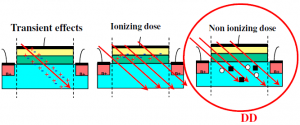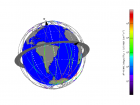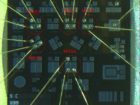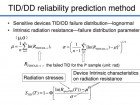Goal of the study
• Propose a DD test standard
• Should be available by the end of the year after ESA and Components
Technology Board (CTB)/Radiation Working group (RWG) comments
• Goal of this presentation
⇒ Not a draft of the future guidelines, but:
• Remind the physical processes responsible of the displacement damages
• Remind the electrical effects
• List the main parameters that should be taken into account
Speaker:
Thierry Nuns. Senior Engineer at Space Environment Group at ONERA.
Working on the developing of a European standard for DD testing
Energy transfer from particle to matter
- Particle slowed down by transfering energy to the matter.

- Main part of the deposited energy is ionisation (interaction with the electrons), the rest is atomic displacements (interaction with the nuclei).
- Fraction depends on particle type and energy, target material.
- Fraction decreases when the energy increases.
- Displacement damage: degradation in the bulk of the device.
Particle matter interaction for DD
3 main interaction types, different energy transfers:
• Coulombian
• Nuclear elastic
• Nuclear inelastic
Increasing transfered energy to the Primary Knock-on Atom and cascade size
Consequence
• Single displaced atom or interaction cascade
• Creation of Frenkel pairs (vacancy-interstitial pairs) or more complex lattice defects (high concentration of deposited energy)
• Reorganisation of these pairs into stable defects. Phase of “annealing”
• Introduction of levels in the gap that modify the electrical properties of semiconducto
Download or read the full report here
GDE Error: Unable to load requested profile.
Latest posts by Media ATN (see all)
- Quantum Key Distribution - 7th November 2022
- Conducted Immunity - 20th May 2019
- Electrical transients Test - 2nd May 2019




